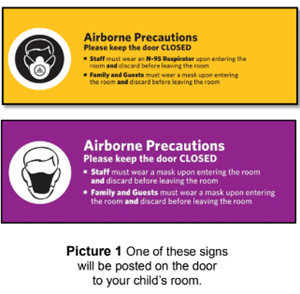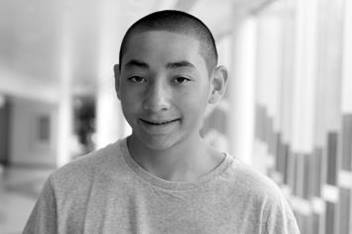Airborne Precautions
![]()
Doctors, nurses and other health care workers must always use standard precautions (good hand washing prior to entering your child’s room and after leaving your child’s room) to limit the risk of spreading infections. Health care workers may use gloves, gowns, masks, eye protection or face shields when taking care of your child.
These precautions are required by Federal law at all hospitals to protect patients as well as health care workers.
Transmission-based precautions (isolation) are used along with standard precautions when the spread of infection might not be completely stopped when using only standard precautions.
- The purpose of these precautions is to keep germs from spreading from your child to other patients, family members, visitors or healthcare workers. When these precautions are not followed, germs could spread to other people, making them very sick.
- Sometimes children will be placed in more than one level of precaution. In this case, both precautions must be followed. For example, if your child is on contact and airborne precautions, the precautions would include a gown, gloves, and a mask.
Airborne Precautions
Airborne precautions are used when germs, such as the kind that cause tuberculosis (TB) and chickenpox, can be spread through the air from one person to another. Your child may be placed on airborne precautions as a safety measure if he or she has symptoms of these germs or if laboratory results show that your child has these germs.
Your child may need to stay in airborne precautions even if he or she seems to be well. This is because some germs can still be spread to other people from your child. Your child will need to stay in his or her room unless taken out of the room by a staff member for testing or procedures.
Airborne precautions can be frustrating for a child. A child life specialist may help by providing play activities.
Ways you can help your child:
- Spend as much time as possible with your child or have a family member or friend stay.
- Activities such as reading, playing games, music, puppet play, drawing, painting pictures, puzzles and looking at family pictures.
What Airborne Precautions Means

Either a purple or gold sign will be posted at the entrance to the room when these precautions are needed so that everyone entering knows what to wear (Picture 1).
Everyone (parents, family, guests, and healthcare workers) must wash their hands with soap and water or use waterless alcohol-based hand rub when entering and leaving the room.
- The door must be closed unless you are entering or exiting the room.
- A mask MUST be worn by everyone in your child’s room.
Masks
- Masks must be worn by all persons entering your child’s room.

- The mask must cover both your nose and mouth.
- Whenever you leave your child’s room, throw away used masks in the trash can inside his room. Do not touch the mask itself. Handle it only by the ear loops or ties.
- When your mask becomes damp replace it with a new one.
Hand Hygiene
Hand hygiene involves either washing hands with soap and water or killing germs on the hands with a waterless alcohol-based hand rub. Proper hand hygiene is one of the best ways to stop the spread of germs and prevent infections. To prevent your child or yourself from getting unwanted germs, wash hands with soap and water or use a waterless alcohol-based hand rub every time you enter and leave the room.
Wash your hands with soap and water at these times:
- Before eating
- When hands have dirt on them
- After changing diapers
- After using the restroom
- After contact

To Use the Waterless Alcohol-based Hand Rub:
- Apply the rub to the palms of your hands.
- Rub your hands together covering all surfaces.
- Rub until your hands are dry.
All doctors, nurses, and other healthcare workers know they must perform proper hand hygiene before and after touching a patient, after contact with items near the patient, before putting on gloves for a sterile procedure and after removing gloves. It is all right for you to remind them to perform hand hygiene.
Before You Leave Your Child’s Room
- Remove the mask.
- Perform hand hygiene.
Parents Who Have Symptoms of TB:
- Must put on a new mask and wear it whenever they are entering the hospital.
- When coming to the hospital to visit, go directly to your child’s room.
- May not leave the room for any reason, except to leave the hospital.
- If your child is on Airborne Precautions, before leaving your child’s room you must:
- Remove your mask and throw it away in the trash can in your child’s room.
- Wash your hands.
- Put on a new mask to wear outside your child’s room to leave the hospital.
- To protect others from TB, there may be times that you will not be allowed to visit.
If you have any questions, be sure to ask a member of your child’s healthcare team.
HH-II-177 8/08, Revised 8/17 Copyright 2008, Nationwide Children’s Hospital


